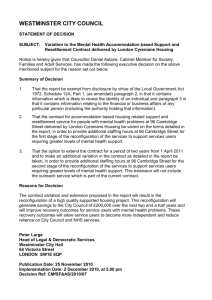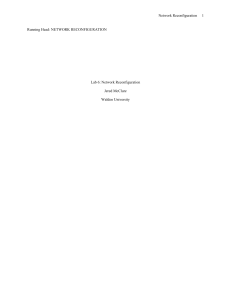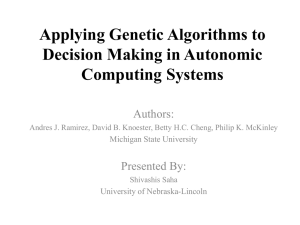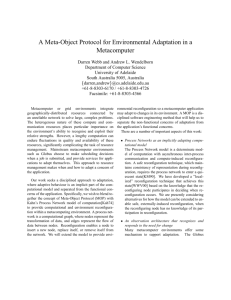Abstract
advertisement
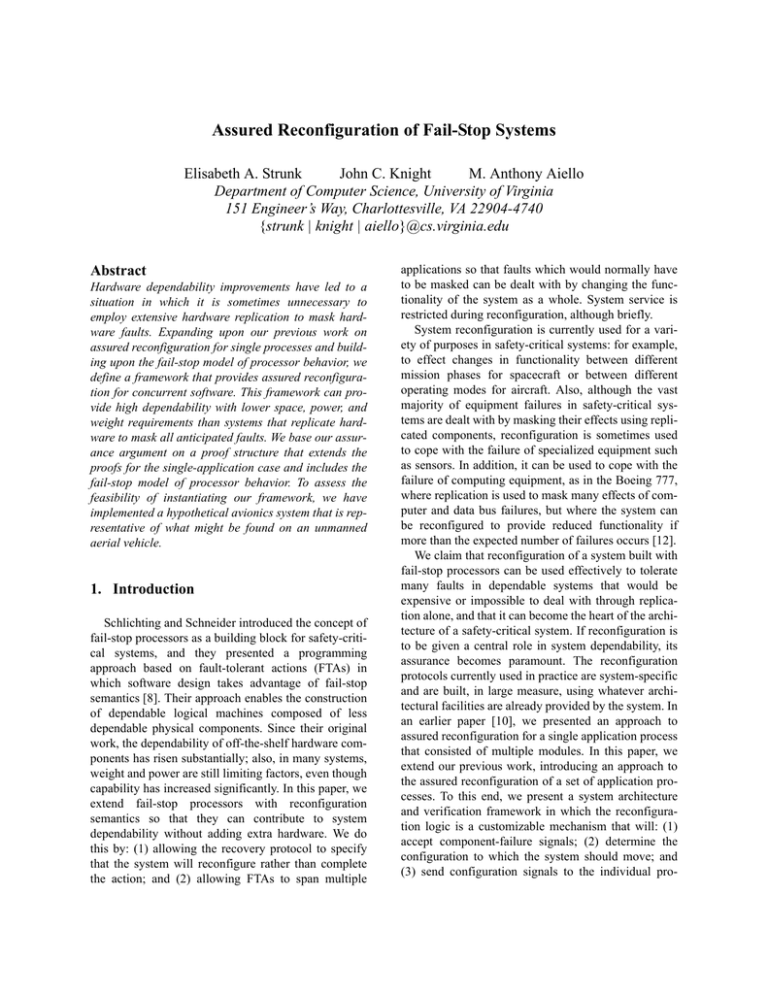
Assured Reconfiguration of Fail-Stop Systems
Elisabeth A. Strunk
John C. Knight
M. Anthony Aiello
Department of Computer Science, University of Virginia
151 Engineer’s Way, Charlottesville, VA 22904-4740
{strunk | knight | aiello}@cs.virginia.edu
Abstract
Hardware dependability improvements have led to a
situation in which it is sometimes unnecessary to
employ extensive hardware replication to mask hardware faults. Expanding upon our previous work on
assured reconfiguration for single processes and building upon the fail-stop model of processor behavior, we
define a framework that provides assured reconfiguration for concurrent software. This framework can provide high dependability with lower space, power, and
weight requirements than systems that replicate hardware to mask all anticipated faults. We base our assurance argument on a proof structure that extends the
proofs for the single-application case and includes the
fail-stop model of processor behavior. To assess the
feasibility of instantiating our framework, we have
implemented a hypothetical avionics system that is representative of what might be found on an unmanned
aerial vehicle.
1. Introduction
Schlichting and Schneider introduced the concept of
fail-stop processors as a building block for safety-critical systems, and they presented a programming
approach based on fault-tolerant actions (FTAs) in
which software design takes advantage of fail-stop
semantics [8]. Their approach enables the construction
of dependable logical machines composed of less
dependable physical components. Since their original
work, the dependability of off-the-shelf hardware components has risen substantially; also, in many systems,
weight and power are still limiting factors, even though
capability has increased significantly. In this paper, we
extend fail-stop processors with reconfiguration
semantics so that they can contribute to system
dependability without adding extra hardware. We do
this by: (1) allowing the recovery protocol to specify
that the system will reconfigure rather than complete
the action; and (2) allowing FTAs to span multiple
applications so that faults which would normally have
to be masked can be dealt with by changing the functionality of the system as a whole. System service is
restricted during reconfiguration, although briefly.
System reconfiguration is currently used for a variety of purposes in safety-critical systems: for example,
to effect changes in functionality between different
mission phases for spacecraft or between different
operating modes for aircraft. Also, although the vast
majority of equipment failures in safety-critical systems are dealt with by masking their effects using replicated components, reconfiguration is sometimes used
to cope with the failure of specialized equipment such
as sensors. In addition, it can be used to cope with the
failure of computing equipment, as in the Boeing 777,
where replication is used to mask many effects of computer and data bus failures, but where the system can
be reconfigured to provide reduced functionality if
more than the expected number of failures occurs [12].
We claim that reconfiguration of a system built with
fail-stop processors can be used effectively to tolerate
many faults in dependable systems that would be
expensive or impossible to deal with through replication alone, and that it can become the heart of the architecture of a safety-critical system. If reconfiguration is
to be given a central role in system dependability, its
assurance becomes paramount. The reconfiguration
protocols currently used in practice are system-specific
and are built, in large measure, using whatever architectural facilities are already provided by the system. In
an earlier paper [10], we presented an approach to
assured reconfiguration for a single application process
that consisted of multiple modules. In this paper, we
extend our previous work, introducing an approach to
the assured reconfiguration of a set of application processes. To this end, we present a system architecture
and verification framework in which the reconfiguration logic is a customizable mechanism that will: (1)
accept component-failure signals; (2) determine the
configuration to which the system should move; and
(3) send configuration signals to the individual pro-
cesses to cause them to respond properly to component
failure. To meet our assurance goal, we have shown
that our architecture satisfies a generalized version of
the single-application properties.
To illustrate the ideas that we describe, we have built
part of a hypothetical avionics system that is typical of
what might be found on a modern general-aviation aircraft or an unmanned aerial vehicle (UAV). The system
includes a flight control application, an electrical
power generation monitoring application, and an autopilot. The parts of these applications that are relevant to
our research have been implemented, although the
functionality is merely representative.
In section 2 we review related work, and in section 3
we introduce our system architecture. Assumptions are
listed section 4. We review Schlichting and Schneider’s
work in section 5. In section 6 we present our formal
model of reconfiguration. Our example avionics system is described in section 7. Section 8 concludes.
2. Related work
Other researchers have proposed the use of reconfiguration to increase system dependability in a variety of
contexts. Shelton and Koopman have studied the identification and application of useful alternative functionalities that a system might provide in the event of
hardware component failure [9]. Their work is focused,
however, more on reconfiguration requirements than
effecting the reconfigurations themselves. Sha has
studied the implementation of reconfiguration in fault
tolerance for control systems [7], although his work
does not focus on assurance. Likewise, Garlan et al. [2]
have proposed the use of software architectural styles
as a general method of error detection and reconfigura-
tion execution to improve dependability, but they do
not present a method of assuring their styles.
In large networked systems, reconfiguration in
response to failures is known as information system
survivability. Informally, a survivable system is one
that has facilities to provide one or more alternative
services (degraded, less dependable, or otherwise different) in a given operating environment [4]. For networked systems, the loss of a single component or even
a moderate number of randomly-distributed components must be expected. System reconfiguration is
employed only in the event of damage with significant
consequences, or if moderate numbers of failures suggest a common cause. The main challenge of reconfiguration in these systems is managing system scale.
Our work is part of a framework for using reconfiguration in embedded real-time systems. The embedded
system reconfiguration requirements are similar to the
networked system requirements, with three key differences: (1) the system is much smaller than large-scale
information systems and thus can be tightly controlled;
(2) the system might be expected to respond much
more quickly to a failure and thus have hard real-time
reconfiguration requirements; and (3) a failure of any
application to carry out a reconfiguration can have a
much greater impact on the system, and so the assurance requirements of a functional transition are much
more demanding.
3. System architecture overview
To introduce the elements of our architecture and
show how they fit together, we begin with an overview,
illustrated in Figure 1. The architecture assumes a distributed computing platform consisting of an unspeci-
Application interaction
Application N
Application 1
Reconfiguration
signals
Application fault and
reconfiguration status signals
Reconfiguration
signals
System Control Reconfiguration Analysis and Management Kernel
System
calls
Hardware fault signals
System
calls
Real-Time Operating System
Computing Platform: Processing Units, Communications Facilities, Network Support, Sensors, Etc.
Figure 1. Logical System Architecture
fied number of processing elements that communicate
via an ultra-dependable, real-time data bus. Each processing element consists of a fail-stop processor with
associated volatile and stable storage that executes a
real-time operating system. An example fail-stop processor might be a self-checking pair; an example data
bus might be one based on the time-triggered
architecture [5]; and an example operating system
might be one that complies with the ARINC 653
specification [1]. Sensors and actuators that are used in
typical control applications are connected to the data
bus via interface units that employ the communications
protocol required by the data bus.
The system that the architecture supports consists of
a set of applications, each of which operates as an independent process with no assumptions on how processes
are mapped to platform nodes except that the mapping
is statically determined. Applications communicate via
message passing or by sharing state through the processors’ stable storage.
Each application implements a set of specifications
and
provides
an
interface
for
internal
reconfiguration [6]. Each specification for each application is defined by domain experts; certain specification combinations, denoted configurations and defined
in a reconfiguration specification [11], provide acceptable services. Reconfiguration is the transition from
one configuration to another. Reconfiguration and its
assurance are the heart of our architecture.
System reconfiguration is effected by the System
Control Reconfiguration Analysis and Management
(SCRAM) kernel. This kernel implements the external
reconfiguration [6] portion of the architecture by
receiving component failure signals when they occur
and determining necessary reconfiguration actions
based on a statically-defined set of valid system transitions. Component failures are detected by conventional
means such as activity, timing, and signal monitors. A
detected component failure is communicated to the
SCRAM via an abstract signal, and the kernel effects
reconfiguration by sending sequences of messages to
each application’s reconfiguration interface.
The reconfiguration message sequence causes operating applications to stop executing their current specification, establish a postcondition from which a new
specification can be started, and initiate operation in a
pre-determined new specification. Each application
meets prescribed time bounds for each stage of the
reconfiguration activity, thereby ensuring that reconfiguration is always completed in bounded time.
The time and service guarantees that our architecture provides hinge on the correct and timely operation
of the SCRAM. A dependable implementation of this
function could be created in various ways, such as distributing it over multiple processors and protecting it
against failure of a subset of those processors, or allocating it to a fail-stop processor so that any faults in its
hardware will be masked. We do not address the specifics of the SCRAM implementation in this paper.
4. System assumptions
We state here the primary assumptions we make on
system requirements. These assumptions are those necessary for our architecture to be applicable to a system;
additional assumptions made for simplicity are
addressed as needed throughout the rest of the paper.
First, we assume that a system is synchronous and
made up of a set of applications Apps = {a1, a2, ...,
am}, which may run on an arbitrary processor configuration, and which may interact. Each ai in Apps possesses a set of possible functional specifications Si =
{si1, si2, ..., sin} and always operates in accordance
with one of those specifications unless engaged in
reconfiguration. Any functional dependencies among
the applications in Apps must be acyclic.
Second, we assume that it is possible to know in
advance all of the desired potential system configurations C = {c1, c2, ..., cp} and how to choose between
them. The system will have at least one “safe” configuration, which is built with high enough dependability
that failures at the rate anticipated for the safe configuration do not compromise system dependability goals.
Third, we assume that system function can be
restricted while the system is reconfigured. We discuss
time bounds on function restriction in section 5.3.
Finally, we assume fail-stop computers and standard
hardware error detection (and, in some cases, masking)
mechanisms for other system elements. We assume the
existence of a reconfiguration trigger; the source of the
trigger might be a hardware failure, a software functional failure, the failure of software to meet its timing
constraints, or a change in the external environment
that necessitates reconfiguration but involves no failure
at all. We do not address error detection mechanisms
for any system component.
5. Fail-stop processors and fail-stop
processes
Fundamental to the thesis of this paper is that component failure occurs in safety-critical systems and
need not be masked, provided the system can be made
reconfigurable. To have confidence in the function and
dependability of a reconfigurable architecture, complete definitions of the failure semantics of all components that are expected to fail must be provided. The
most desirable semantics are those referred to as failstop. In this section, we review the concept underlying
fail-stop processors, discuss their use, and summarize
our approach to reconfiguration using them.
5.1 Fail-stop processors
Schlichting and Schneider define a fail-stop processor as consisting of one or more processing units, volatile storage, and stable storage [8]. A fail-stop
processor’s failure semantics can be summarized as:
• The processor stops executing at the end of the last
instruction that it completed successfully.
• The contents of volatile storage are lost, but the contents of stable storage are preserved.
An embedded system of the type discussed in this
paper is made up of a collection of fail-stop processors.
If one processor fails, the others poll its stable storage
to find out what state it was in when it failed. If necessary, the system then reconfigures to meet its reconfiguration specification. In a system where faults are
masked (as is assumed by Schlichting and Schneider),
there must be sufficient equipment available to provide
full service if the anticipated number of component
failures occurs during the maximum planned mission
time. The total number of required components is thus
the sum of the maximum number expected to fail during the longest planned mission and the minimum
number needed to provide full service. Though not
impossible, loss of the maximum number expected to
fail is an extremely unlikely occurrence. Thus, the vast
majority of the time, the system will be operating with
far more computing resources than it needs.
With the approach we advocate, the total number of
required components is the sum of the maximum number expected to fail during the longest planned mission
and the minimum number needed to provide the most
basic form of safe service. If the system were designed
so that this number equals the number of components
needed to provide full service, then, during routine
operation (i.e., the vast majority of the time), the system would operate with no excess equipment. Even if
some system functions do not meet the assumptions
listed in the previous section, failures of those functions can be masked, while failures in other functions
can trigger a reconfiguration. Reconfiguration in place
of masking, or the combination of reconfiguration with
masking, saves power, weight, and space.
5.2 Software considerations in fail-stop
processors
Schlichting and Schneider introduced the concept of
a fault-tolerant action (FTA) as a building block for
programming systems of fail-stop processors. Briefly,
an FTA is a software operation that either: (1) completes a correctly-executed action A on a functioning
processor; or (2) experiences a hardware failure that
precludes the completion of A and, when restarted on
another processor, completes a specified recovery
action R. Thus, an FTA is composed of either a single
action, or an action and a number of recoveries equal to
the number of failures experienced during the FTA’s
execution. Using FTAs, Schlichting and Schneider
show how application software can be constructed so
as to mask the functional effects of a fail-stop processor failure and how proofs can be constructed to show
that state is properly maintained.
In the original framework, a recovery protocol may
complete only the original action, either by restarting it
or by some alternative means. Our framework takes a
broader view of the recovery protocol, where R might
be the reconfiguration of the system so that the next A
will complete some useful but different function. An
FTA in our framework, then, leaves the system either
having carried out the function requested, or having put
itself into a state where the next action can carry out
some suitable but possibly different function.
In the approach presented here, the basic software
building block is a reconfigurable application. Where
the meaning is clear, we refer to a reconfigurable application as an application in the remainder of this paper.
An application has a predetermined set of specifications with which it can comply and, correspondingly, a
predetermined set of fault-tolerant actions that are
appropriate under each specification. Which recovery
protocol is appropriate for use when an application
fails, however, cannot be determined by the application
alone since the application’s function exists in a system
context. Furthermore, applications may depend on one
another, so that the initial failure of an action in one
application could lead to the failure of an action in
another application. This issue did not arise in the previous formulation of fail stop since failures were completely masked; with the possibility of reconfiguration,
however, a distinction must be drawn between application FTAs (AFTAs) and system FTAs (SFTAs).
An AFTA is an action encompassing a single unit of
work for an individual application. An SFTA is composed of a set of AFTAs. Because of system synchrony,
there is some time span in which each application will
have executed a fixed number of AFTAs. The AFTAs
that are executed during that time span make up the
SFTA. If an application experiences a failure but
recovers from that failure without affecting any other
applications, then the SFTA includes that application’s
action and subsequent recovery, as well as the standard
AFTAs for the other applications.
Because an application failure can affect other applications, some mechanism for determining what other
application reconfigurations are necessary to complete
an SFTA is required. It is for this purpose that we introduce the System Control Reconfiguration Analysis and
Management (SCRAM) kernel. Possible configurations to which the system might move to complete its
SFTA are statically defined as set of valid system transitions and a function to determine which transitions
must be taken under each possible set of operating circumstances. The SCRAM signals the remaining applications to effect the appropriate reconfiguration.
A software system composed of reconfigurable
applications can be reconfigured to meet a given system specification, provided appropriate configurations
exist for all the applications. Transition existence can
be guaranteed in a straightforward way by including a
coverage requirement over environmental transitions,
potential failures, and permissible reconfigurations.
Applications lost due to a processor failure are
known to have been lost because of the static association of applications to processors. We assume nothing
about the state of an application when it fails.
5.3 Real-time behavior of fail-stop software
We define a reconfigurable application to have the
following informal properties:
• The application responds to an external halt signal
by establishing a prescribed postcondition and halting in bounded time.
• The application responds to an external reconfiguration signal by establishing the precondition necessary for the new configuration in bounded time.
• The application responds to an external start signal
by starting operation in whatever configuration it has
been assigned in bounded time.
We model time at the system level by associating uniform timing bounds with each stage of each AFTA.
Because of the precise semantics of an SFTA, timing
guarantees can be given for SFTAs based on the
bounds provided for AFTAs for a reconfiguration that
is able to complete with no intervening failures.
While Schlichting and Schneider’s work includes a
discussion of system temporal properties in the event
of multiple successive failures, including how one
might guarantee liveness, we extend the framework to
cover reconfiguration timing for systems that must
operate in hard real time. Any failures that occur during reconfiguration can be either (1) addressed immediately by ensuring the applications have met their
postconditions and choosing a different target specification; or (2) buffered until the next stable storage
commit of other applications, depending on system
requirements. In the worst case, each failure cannot be
dealt with until the end of the current reconfiguration.
In this case, the longest restriction of system function is
equal to the sum of the maximum time allowed
between each reconfiguration in the longest chain of
transitions to some safe system configuration Cs. In
other words, for the longest configuration chain C1, C2,
..., Cs, the maximum restriction time is Σi=2 to s Ti-1, i,
where Ti, j is the maximum time to transition from Ci to
Cj. This time can be reduced in various ways, such as
interposing a safe configuration Cs in between any
transition between two unsafe configurations. With this
addition, the new maximum time over all possible system transitions Ci → Cj would be max{Ti, s}.
One caveat of this formula is that cyclic reconfiguration is possible due to repeated failure and repair or
rapidly-changing environmental conditions, and in this
case the time to reconfigure could be infinite. Potential
cycles can be detected through a static analysis of permissible transitions. They can be dealt with by forcing
a check that the system has been functional for the necessary amount of time (in a safe configuration, or in a
configuration appropriate to all environmental conditions) before a subsequent reconfiguration takes place.
6. Formal model
The above discussion gives an overview of how we
have extended Schlichting and Schneider’s work to
support reconfiguration, but, as an informal discussion,
it lacks the rigor necessary for assurance of dependable
systems. To provide this assurance, we have created an
assurance argument that is an extension of that presented in our previous work [10]. The assurance argument includes: (1) a formal model of a reconfigurable
system architecture; (2) a set of formal properties,
stated as putative theorems over the model, that we use
as our definition of system reconfiguration; and (3)
proofs of the theorems—which constitute a proof that
the architecture satisfies the definition. With this verification framework in place, we know that any instance
of that architecture will be a valid instance of a recon-
figurable system as long as the proof obligations generated by the formal type system have been met.
Our formal model is specified in PVS, and proofs of
the putative theorems have been mechanically verified
with the PVS system. We have also formally specified
the essential interfaces of an example reconfigurable
system (see section 7) and shown that this example has
the necessary properties of our architecture. The result
is an assurance argument based on proof. In this section, we present the model and its properties.
6.1 Model assumptions
Assuring real-time properties is difficult in general;
although PVS is a powerful specification and proving
system, real-time properties of complex systems can be
nontrivial. In this work, in order to enable the specification and proof structure that we seek, we make the
following general assumptions on applicable systems:
• Each application operates with synchronous, cyclic
processing and with a fixed real-time frame length.
• All applications operate with the same real-time
frame length.
• The real-time frames for all applications are synchronized to start together.
• Each application completes one unit of work in each
real-time frame (where that unit of work can be normal function, halting an application and restoring its
state, preparing an application to transition to
another specification, or initializing data such as
control system gains).
• Each application commits results to stable storage at
the end of each computation cycle (real-time frame).
• Any dependencies between applications require only
that the independent application be halted before the
dependent application computes its precondition.
These assumptions impose restrictions on a system
to facilitate analysis. Despite these assumptions, the
model presented here supports the development of a
useful class of systems.
6.2 Application model
During normal operation, each application reads
data values produced by other applications from stable
storage at the start of each computational cycle and
then performs its computation. It commits its results
back to stable storage at the end of each computational
cycle. Should reconfiguration become necessary, the
AFTAs are not able to execute their recovery protocols
immediately or independently because they depend
both on their own state and on other system state. Each
must wait, therefore, for the SCRAM to coordinate all
of the currently executing AFTAs.
The SCRAM communicates with applications
through variables in stable storage. When reconfiguration is necessary, it sets the configuration_status variable to a sequence of values on three successive realtime frames. The three values are: halt, prepare, and
initialize. At the beginning of each real-time frame,
each application reads its configuration_status variable
and completes the required action during that frame as
shown in Table 1.
6.3 System model
The SCRAM effects a system reconfiguration by
reconfiguring all of the applications in the system
using the sequence of actions shown in Table 1. In the
table, application i has failed, and the new system configuration will be Ct. The various sequences are coordinated by the SCRAM to ensure that dependencies
among AFTAs are respected.
This approach differs slightly from the approach
taken by Schlichting and Schneider. In their approach,
system processing is achieved by the execution of a
sequence of FTAs where the recovery for a given FTA
Table 1: SFTA Phases
Frame
0 (start)
Message
Action
Application i:
Predicate
None
None
None
SCRAM:
prepare(Ct) → all apps
Applications cease execution
Applications prepare to transition to Ct
Application postconditions
Application transition conditions for Ct
SCRAM:
Applications initialize, establish operating state for Ct
Application preconditions for Ct
failure signal→ SCRAM
SCRAM:
halt
1
2
3
(end)
→ all apps
initialize
→ all apps
is executed after the associated action if it is interrupted. In our approach, the recovery for a system
fault-tolerant action that is interrupted consists of three
parts: (Frame 1) each executing AFTA establishes a
required postcondition and reaches a halted state;
(Frame 2) each executing AFTA establishes the condition to transition to operation under the new state; and
(Frame 3) each executing AFTA establishes its precondition: all state associated with the AFTA has been initialized, and the application is functioning normally.
The functional aspects of the SCRAM will remain
constant, unless changes are needed because of specific
dependencies. This simplifies subsequent verification,
since the SCRAM need only be verified once. The
SCRAM must, however, be provided with applicationspecific data that is created and verified separately:
• An interface to one or more applications that monitor environmental characteristics. These applications calculate the effective state of the environment.
• A table of potential configurations. This
defines
potential system configurations and maps system
configurations into application specifications.
• A function to choose a new configuration. The
function maps current configuration and environment state to a new configuration. This function
implicitly includes information on valid transitions.
• An interface to each application. This contains the
configuration variable for the application.
Our formal system model includes an overarching
function in the PVS specification to coordinate and
control application execution. This is a mechanism that
is present as part of the PVS structure; in practice, timing analysis and synchronization primitives would be
used to achieve frame coordination. Variables in stable
storage shared between the SCRAM and the relevant
application ensure synchronization during reconfiguration stages; the synchronization, in turn, ensures preservation of data dependencies.
The SCRAM’s synchronization mechanism can be
extended to support richer application interdependencies, as long as the dependencies are acyclic and time
permits. Given a specification of dependencies, it
could preserve them by checking each cycle to see if
the independent application has completed its current
configuration phase. Only after that phase is complete
would the SCRAM signal the dependent application to
begin its next stage. Dependencies could also be
relaxed by removing any unnecessary intermediate
stages or allowing the applications to complete multiple sequential stages without signals from the SCRAM.
Since we make no distinction between failures and
other environmental changes, the status of a compo-
nent is modeled as an element of the environment, and
a failure is simply a change in the environment. Any
environmental factor whose change could necessitate a
reconfiguration can have a virtual application to monitor its status and generate a signal if the value changes.
6.4 Formal definition of reconfiguration
Using the above model, we now outline the highlevel properties we require of any reconfiguration.
Defining these properties in an abstract sense allows us
to argue that the general requirements needed for
assured reconfiguration have been met. The model was
constructed to enable proof of these properties.
In previous work, we informally defined reconfiguration of a single application as:
the process through which a system halts operation under its current source specification Si and
begins operation under a different target specification Sj [10].
For the multiple application case, we define reconfiguration informally as:
the operation through which a function
f: Apps → S of interacting applications A that
operate according to certain specifications in S
transitions to a function f': Apps → S of interacting applications Apps that operate according to
different specifications in S.
An SFTA is thus comprised of correct execution of
all applications ai under their respective specifications
f(ai). System reconfiguration is only necessary if ai
cannot mask the failure, but must transition to an alternative specification in order to complete its AFTA. If
only ai must reconfigure, then ∀aj ≠ ai, f'(aj) = f(aj).
For our system model, including application specification and system configuration types, we created
properties that we use to define “correct” reconfiguration, shown in Table 2. To represent them, we include:
reconfiguration: TYPE =
[# start_c: cycle, end_c: cycle #]
— execution cycle in which the reconfiguration
starts and ends
sys_trace : TYPE =
— possible state traces
[# ...
sp: reconf_spec,
— sp‘apps is the set of system applications
tr: [cycle -> s: sys_state],
— function from system cycle to system state
Table 2: Formal Properties of System Reconfiguration
Informal Description
Formal Property
FORALL
(s: sys_trace, r: (get_reconfigs(s))) :
SP1: R begins at the same
(EXISTS (app: (s`sp`apps)) :
s`tr(r`start_c)`reconf_st(app) = interrupted) AND
(FORALL (app: (s`sp`apps)) :
s`tr(r`start_c-1)`reconf_st(app) = normal) AND
(FORALL (app: (s`sp`apps)) :
s`tr(r`end_c)`reconf_st(app) = normal) AND
(FORALL (c: cycle, app: (s`sp`apps)) :
r`start_c < c AND c < r`end_c =>
s`tr(c)`reconf_st(app) /= normal)
FORALL
(s: sys_trace, r: (get_reconfigs(s))) :
SP2: Cj is the proper choice
EXISTS (c: real_time) :
for the target system specr`start_c <= c AND c <= r`end_c AND
ification at some point
s`tr(r`end_c)`svclvl =
during R
s`sp`choose(s`tr(r`start_c)`svclvl,
s`env(c*cycle_time))
FORALL
(s:
sys_trace,
r: (get_reconfigs(s))) :
SP3: R takes less than or
(r`end_c
r`start_c
+ 1)*cycle_time <=
equal to Tij time units
s`sp`T(s`tr(r`start_c)`svclvl, s`tr(r`end_c)`svclvl)
SP4: The precondition for Cj FORALL (s: sys_trace, r: (get_reconfigs(s))) :
pre?(s, r`end_c)
is true at the time R ends
time any application in the
system is no longer operating under Ci and ends
when all applications are
operating under Cj
env: valid_env_trace(sp`E, sp`R) #]
— given environmental states
get_reconfigs(s: sys_trace) :
set[reconfiguration]
— set of all system reconfigurations
Formally, an SFTA is an action R in which the conditions in Table 2 hold. We have proven the properties in
Table 2 directly from our abstract formal specification
using the PVS system. The specification is a set of
types that enforces all of the desired system properties
by placing type restrictions on any instantiation. In our
case, an instantiation of the PVS architecture would be
a PVS specification itself. The powerful type mechanisms of PVS are used to automatically generate all of
the proof obligations required to verify that a system
instance is compliant with the desired properties. In
this work, we have proven all of the desired properties
of our abstract specification in PVS, and the PVS proof
checker has mechanically verified that the proofs are
sound (thus we do not include the proofs here).
7. Example instantiation
To assess the feasibility of the approach outlined in
this paper and to demonstrate the concepts that constitute the approach, we have implemented an example
reconfigurable system. The system is a hypothetical
avionics system that is representative, in part, of what
might be found on a modern UAV or general-aviation
aircraft. The example includes two functional applications: an autopilot and a flight control system (FCS).
Only minimal versions of application functionality
have been implemented since the system is not
intended for operational use. However, each application has a complete reconfiguration interface, including
the capability to provide multiple functionalities. An
electrical power generation system is modeled as an
environmental factor that might necessitate a reconfiguration.
In its primary specification, the autopilot provides
four services to aid the pilot: altitude hold, heading
hold, climb to altitude, and turn to heading. It also
implements a second specification in which it provides
altitude hold only. Its second specification requires
substantially less processing and memory resources.
The FCS provides a single service in its primary
specification: it accepts input from the pilot or autopilot and generates commands for the control surface
actuators. This primary specification could include stability augmentation facilities designed to reduce pilot
workload, although we merely simulate this. The FCS
also implements a second specification in which it provides direct control only, i.e., it applies commands
directly to the control surfaces without any augmentation of its input. As with the autopilot, when operating
under this specification, the FCS requires less processing and memory resources.
The electrical system consists of two alternators and
a battery, and its interface exports the state that it is in.
One alternator provides primary vehicle power; the
second is a spare, but normally charges the battery,
which is an emergency power source. Loss of one
alternator reduces available power below the threshold
needed for full operation. Loss of both alternators
leaves the battery as the only power source. The electrical system operates independently of the reconfigurable system; it merely provides the system details of
its state. For illustration, the anticipated component
failures for which reconfiguration takes place are all
based on the electrical system.
Our system can operate in three configurations:
• Full Service. Full power is available, and all of the
platform computing equipment can be used. The
autopilot and FCS provide full service, and each
operates on a separate computer.
• Reduced Service. Power is available from only one
alternator or the battery, and some of the platform
computing equipment has to be shut down. The
applications must share a single computer that does
not have the capacity to support full service from the
applications, so the autopilot provides altitude hold
service only and the FCS provides direct control.
• Minimal Service. In this configuration, power is
available from the battery only, and the remaining
platform computing equipment has to be switched to
its low-power operating mode. The applications
must share a single computer that is operating in
low-power mode, and so the autopilot is turned off
and the FCS provides direct control.
The reconfiguration interfaces for the two applications described above, the three acceptable configurations, and the transitions between configurations are
specified in PVS. We type checked our instantiation
against the abstract specification described in section 6
and discharged the generated proof obligations.
We have constructed a Java implementation of the
example, but have not verified it against its specification since the focus of this work is at the specification
level. The implementation runs on a set of personal
computers running Red Hat Linux. Real-time operation
is modeled using a virtual clock that is synchronized to
the clocks provided by Linux. A time-triggered, realtime bus and stable storage are simulated. This example has been operated in a simulated environment that
includes aircraft state sensors and a simple model of
aircraft dynamics. Its potential reconfigurations have
been triggered by simulated failures of the electrical
system and executed by the application and SCRAM
instantiations.
7.1 An example system fault tolerant action
In our example, each AFTA is implemented as
described in section 6.2. For illustration, we require
certain hypothetical constraints on system transitions
that manage aircraft dynamics properly. In any transition, the aircraft’s condition in the target configuration
must be known so that processing in the target configuration begins correctly. In this example, we require that
the control surfaces be centered, i.e., not exerting turning forces on the aircraft, and the autopilot be disengaged when a new configuration is entered. These are
thus the preconditions for the FCS and autopilot. The
postcondition that each application must establish prior
to reconfiguration is merely to cease operation.
The specific applications that we have used in this
illustration have no dependencies during their halt
stages because neither requires any support to establish
its postcondition. There is only one dependency during
initialization, namely that the autopilot cannot resume
service in the Reduced Service configuration until the
FCS has completed its reconfiguration—the autopilot
cannot effect control without the other application.
Suppose that the system is operating in the Full Service configuration and an alternator fails. The electrical
system will switch to use the other alternator, and its
interface will inform the SCRAM of the failure. The
autopilot and flight control applications are unable to
complete their AFTAs within the allotted time because
there is not enough power to run them both at full service; however, their postconditions are simply to cease
operation, and so this does not pose a problem. Based
on the static reconfiguration table, the SCRAM commands a change to the Reduced Service configuration.
The system reconfiguration is implemented using the
sequence shown in Table 1 to complete its SFTA.
7.2 Properties of the example instantiation
As discussed above, the formal properties from section 6.4 are enforced in specification instantiations
through the type system. PVS does this by generating
type-correctness conditions (TCCs), a kind of proof
obligation. The example proof obligation in Figure 2,
abbreviated and otherwise edited for clarity, requires
that: (1) the example’s specification levels are of the
type expected as the SCRAM input parameters; and (2)
the covering_txns predicate (which ensures a transition exists for any possible failure-environment pair)
% Subtype TCC generated(at line 117, column 16) for ex_SCRAM_table
% expected type SCRAM_table(ex_apps, extend[...](ex_speclvl)),
% ex_valid_env, ex_reachable_env)
% proved - complete
example_reconf_spec_TCC6: OBLIGATION
FORALL (x: speclvl): ex_speclvl(x) IFF
extend[speclvl, {sp: speclvl | NOT sp = indeterminate}, bool, FALSE]
(restrict[speclvl, {sp: speclvl | NOT sp = indeterminate}, boolean](ex_speclvl))(x)
AND covering_txns(ex_apps, extend[...] (ex_speclvl)), ex_valid_env, ex_reachable_env,
ex_SCRAM_table`txns, ex_SCRAM_table`primary, ex_SCRAM_table`start_env);
Figure 2. Example TCC
must hold for the parameters. We have proven all of the
TCCs generated for the example.
8. Conclusion
Safety-critical systems often use hardware replication to tolerate faults that occur during operation, and
Schlichting and Schneider have presented a theory of
doing this based on the rigorous semantics of fail-stop
processors. Reconfiguring the system in response to
faults, however, can help designers achieve their
dependability goals without necessitating additional
hardware, thus saving weight, power, and space. In this
paper, we have drawn on a previous work in reconfiguration of single applications and the semantics presented by Schlichting and Schneider to create an
architecture and verification framework to use reconfiguration in dependable systems. We address the
requirements of systems of interacting applications,
combining the distributed system aspect of fail stop
with the structured, proof-based assurance of our previous work to address timing as well as temporal characteristics of systems. This enables assurance not only of
liveness, but also of real-time characteristics of system
recovery. To assess the feasibility of our theory in practice, we have presented an example based on a prototypical control system, interpreted our theory in terms
of its specific requirements, and shown how the theoretical properties hold over an instantiation through
type mechanisms.
Acknowledgments
We thank Xiang Yin and Dean Bushey for their
assistance with our example. This work was sponsored,
in part, by NASA under grant number NAG1-02103.
References
[1] ARINC Inc. “Avionics Application Software Standard
Interface.” ARINC Spec. 653, Baltimore, MD, 1997.
[2] Garlan, D., S. Cheng, and B. Schmerl. “Increasing System Dependability through Architecture-based Selfrepair.” Architecting Dependable Systems, R. de Lemos,
C. Gacek, A. Romanovsky (Eds), Springer-Verlag,
2003.
[3] Jahanian, F., and A.K. Mok. “Safety Analysis of Timing
Properties in Real-Time Systems.” IEEE Trans. on Software Engineering, 12(9):890-904.
[4] Knight, J. C., E. A. Strunk and K. J. Sullivan. “Towards
a Rigorous Definition of Information System Survivability.” Proc. 3rd DARPA Information Survivability
Conf. and Exposition, Washington, D.C., April 2003.
[5] Kopetz, H., and G. Bauer, “The Time-Triggered Architecture.” Proc. IEEE, 91(1):112-126, Jan. 2003.
[6] Porcarelli, S., M. Castaldi, F. Di Giandomenico, A. Bondavalli, and P. Inverardi. “A framework for reconfiguration-based fault-tolerance in distributed systems.”
Architecting Dependable Systems II, R. De Lemos, C.
Gacek, and A. Romanovsky (Eds), Springer-Verlag,
2004.
[7] Sha, L. “Using Simplicity to Control Complexity.”
IEEE Software 18(4):20-28.
[8] Schlichting, R. D., and F. B. Schneider. “Fail-stop processors: An approach to designing fault-tolerant computing systems.” ACM Trans. Computing Systems
1(3):222-238.
[9] Shelton, C., and P. Koopman. “Improving System
Dependability with Functional Alternatives.” Proc. 2004
Int’l Conf. Dependable Systems and Networks, Florence, Italy, June 2004.
[10] Strunk, E. A., and J. C. Knight. “Assured Reconfiguration of Embedded Real-Time Software.” Proc. Int’l
Conf. Dependable Systems and Networks, Florence,
Italy, June 2004.
[11] Strunk, E. A., J. C. Knight, and M. A. Aiello. “Distributed Reconfigurable Avionics Architectures.” Proc.
23rd Digital Avionics Systems Conference, Salt Lake
City, UT, Oct. 2004.
[12] Yeh, Y. C. “Triple-Triple Redundant 777 Primary Flight
Computer.” Proc. 1996 IEEE Aerospace Applications
Conference, vol. 1, New York, N.Y., February 1996.
